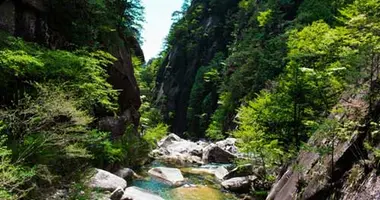Tokyo Dome 東京ドームシティ
What city can boast having an impressive stadium, an amusement park and a spa with natural hot springs, all in one location and in the center of the city? Tokyo of course!
Tokyo Dome City
Tokyo Dome in the Koishikawa district of Tokyo's Bunkyo ward is Japan's biggest indoor baseball stadium, seating over 40,000 people. Tokyo Dome is the major feature in the Tokyo Dome City entertainment complex.
Tokyo Dome History
Tokyo Dome opened in 1988. From 1871 until 1935, the site it is on was Koishikawa Arsenal, producing munitions and early warplanes. After the war, it became the center of Tokyo's cycle racing until 1972 when all sports gambling was prohibited by the city. It became the site of Korakuen Stadium, with a pool and golf shooting range, until Tokyo Dome replaced it in March 1988 as Japan's biggest fully covered baseball stadium.
Tokyo Dome - sport and music venue
Tokyo Dome is the home turf for the Yomiuri Giants baseball team - Japan's most famous ball club.
As a baseball stadium, Tokyo Dome is unusual for having a much larger foul territory than most, with a large number of spectator seats in the foul territory, a high outfield fence: 4.24m (almost 14 ft), and no warning tracks.
Tokyo Dome is also used for a variety of other sporting and cultural events, including football, basketball, pro wrestling, boxing, K-1 kickboxing, and music concerts. International performing artists often play at Tokyo Dome.
Tokyo Dome construction
Tokyo Dome covers 4.67 hectares (about 11.5 acres) and is almost 62 meters (292 ft) high from playing field to roof. The fabric roof is supported by the air pressure being kept a little higher inside the Dome than outside.
Baseball Hall of Fame and Museum
The Baseball Hall of Fame and Museum is housed inside Tokyo Dome, just to the right of Gate 21 of Tokyo Dome. It preserves and exhibits the history and memorabilia of baseball in Japan.
Tokyo Dome Hotel
Tokyo Dome Hotel was added to Tokyo Dome City in 2000, designed by the famous architect, Kenzo Tange. With 43 floors it offers good views of Tokyo, and its central location makes it an excellent base for visiting Tokyo. Includes several restaurants, bars, and other facilities individual and corporate.
Tokyo Dome City Attractions
Tokyo Dome City Attractions is a recreation complex with numerous attractions for all ages. There is a Ferris wheel; various theaters; indoor bowling; several cafes and restaurants, including the Baseball Cafe, a huge restaurant serving Western-style food in a baseball-themed atmosphere; and rides for young children such as the indoor Pixie Cups, and the outdoor Kokokko ride in the Splash Garden. The terrifying, 1,067m- long Thunder Dolphin roller coaster starts with an 80-meter drop, has speeds of up to 130 km/h, and costs 1,030 yen.
TeNQ Space Museum ("ten-cue") is an "entertainment museum" full of audio-visual experiences introducing the excitement and mysteries of the universe and space travel.
Spa LaQua is a rest and relaxation facility occupying floors 5 to 9 of the 9-floor building across the road from Tokyo Dome, offering bathing in natural hot spa water, piped up from several hundred meters below the city. Beauty services, massage and fitness facilities are also available.
Shops, cafes, restaurants occupy all nine floors of the building and are open 11am to 9pm, every day, with cafes and restaurants open until 11pm.
Meets Port
Meets Port is a distinctive cylindrical building on the south-east corner of Tokyo Dome City. Its five floors provide a selection of restaurants, pubs and cafes, as well as a convenience store. The 3rd floor opens out onto a pleasant garden with seating, through which the rest of Tokyo Dome City can be accessed. The establishments in Meets Port generally open from around 11 am (although the Starbucks opens at 7 am) until about 11 pm, depending on the store. Right in front of Meets Port is Exit 2 of the Suidobashi Subway Station on the Mita Line.
Places of Interest near Tokyo Dome
Right next to Tokyo Dome is Koishikawa Korakuen Gardens, a good place to admire the sakura (cherry blossoms) or momiji (autumn leaves) depending on the season. About 1.5km north is the equally beautiful Koishikawa Botanical Gardens belonging to Tokyo University, whose Hongo campus is also near. The Ochanomizu, Kanda, Yushima district, a little south-east of here also has a lot of worthwhile sights, including Kanda Myojin temple, Yushima Seido shrine, Nikolai Cathedral, and the Japan Football Museum. Tokyo's booktown, Jimbocho, is about a 10 minute walk (or one stop on the Mita Subway Line) south of Tokyo Dome, down Hakusan-dori Avenue.
Address, timetable & access
Tokyo Dome
Address
1 Chome-3-61 Koraku, Bunkyo City
112-0004
Japan
Timetable
11am to 9pm, Mon-Fri; 10am to 7pm, Sat, Sun, public holidays, 365 days a year.Price
Anyone is free to enter Tokyo Dome City Attractions free of charge, but a ticket is required to enjoy the attractions themselves.Access
Korakuen Station on the Marunouchi and Namboku subway lines, Exit 2. Kasuga Station on the Oedo subway line. Koraku Station's Exit 2 is accessible from it. Suidobashi Station on the Mita subway line, Exit 2. Suidobashi Station on the JR Chuo/Sobu Line (take yellow Chuo-Sobu line trains only, not the orange Chuo Rapid trains, which don't stop here).Website
https://www.tokyo-dome.co.jp/en/tourists/dome/































